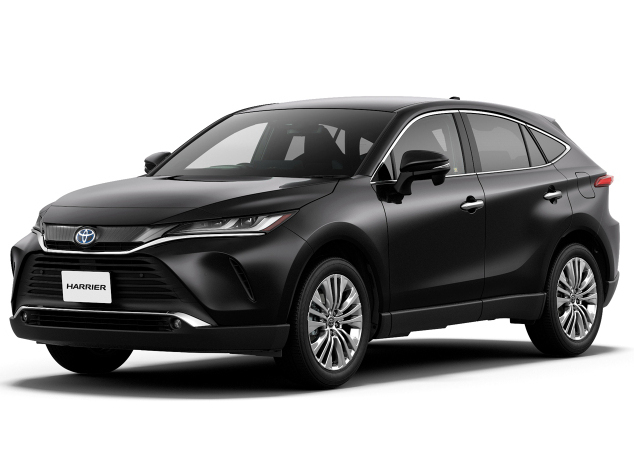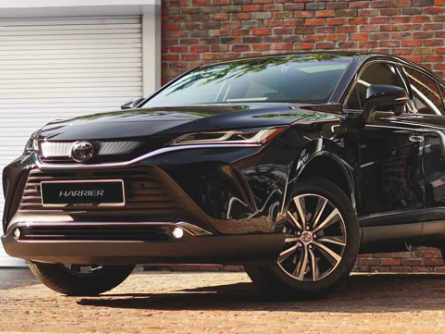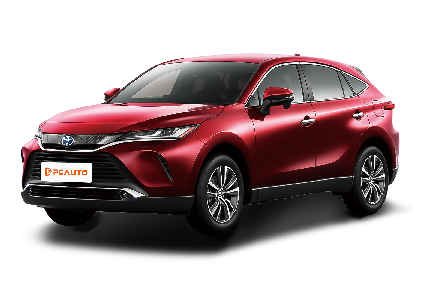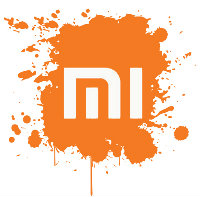Q
What is the Engine Oil Capacity of Toyota Harrier ?
The engine oil capacity of the Toyota Harrier varies depending on the model year and engine type. For example, the common 2.0-liter turbocharged engine (8AR FTS) typically requires about 5.7 liters of oil when including the oil filter. Meanwhile, the 2.5-liter hybrid version (A25A FXS) generally needs around 4.8 liters. However, the exact amount should always be determined using the dipstick to avoid overfilling or underfilling.
In Malaysia’s hot climate, it is recommended to use fully synthetic engine oil that meets Toyota’s SN or SP-grade standards, such as 5W30 or 0W20. These oils are better suited for high temperatures and can help extend engine life. It is essential to check the oil condition regularly, ideally every 5,000 kilometers or six months. If the oil appears dark or has lost its viscosity, it should be changed promptly.
Some newer Harrier models may come with an oil life monitoring system, but it is still advisable for owners to manually inspect the oil level and condition to ensure accuracy. The most reliable reference remains the original maintenance manual, which provides the precise oil capacity and recommended specifications for each specific model.
Special Disclaimer: This content is published by users and does not represent the views or position of PCauto.
Related Q&A
Q
How many types of Toyota Harriers 2023 are there?
In the Malaysian market in 2023, the Toyota Harrier is mainly available in two models: the Harrier 2.0 with a 2.0-liter naturally aspirated engine and the Harrier Hybrid 2.5 equipped with a 2.5-liter hybrid system. Both models feature front-wheel drive configuration. The Harrier 2.0 is suitable for consumers seeking a smooth driving experience, while the Harrier Hybrid attracts buyers who focus on energy-saving with its higher fuel efficiency and environmental-friendly features.
This fifth - generation Harrier is built on the TNGA-K platform. Its exterior design includes "eagle-eye" LED headlights and a through-type taillight. The interior is equipped with a 12.3 - inch touchscreen and a JBL audio system. The Toyota Safety Sense intelligent safety system comes as standard across the range, including functions such as pre-collision warning and lane-keeping assist.
It's worth noting that all Harriers in the Malaysian market are completely built-up (CBU) imports, so the prices are slightly higher than those of completely knocked - down (CKD) locally assembled cars. However, this also ensures the original factory quality. For consumers considering purchasing, it is recommended to choose the power version based on their daily driving mileage. If you often drive long distances, the hybrid version can significantly reduce fuel costs, while the 2.0 - liter version offers better cost - effectiveness for short - distance urban commuting.
Q
What is the life expectancy of a Harrier 2023?
In 2023, the normal service life of the Toyota Harrier in Malaysia can reach 15 to 20 years or cover a mileage of over 250,000 kilometers. The specific lifespan depends on maintenance conditions, driving habits, and road and environmental conditions. Regularly replacing key consumables such as engine oil, transmission fluid, and brake fluid and following the manufacturer's maintenance manual can significantly extend the vehicle's lifespan. As a mid - size SUV under the Toyota brand, the Harrier has a good reputation for its durability, thanks to its mature powertrain and reliable chassis design. The tropical climate in Malaysia has a certain impact on rubber parts and electronic components. It is recommended that car owners check the condition of suspension bushings and wiring harnesses every two years. At the same time, pay attention to anti-rust treatment of the chassis during the rainy season. For the hybrid version, special attention should be paid to the maintenance of the battery cooling system. Good driving habits, such as avoiding frequent rapid acceleration and hard braking, can also reduce mechanical wear. It's worth noting that there is a strong demand for well - maintained Harriers in the Malaysian used-car market, and they have a relatively high residual value. If you plan to use the vehicle for a long time, it is recommended to choose the original factory's extended warranty service for more comprehensive protection.
Q
Is the 2023 Toyota Harrier a 5 seater or 7 seater?
The 2023 Toyota Harrier in the Malaysian market is a 5-seater SUV, and no 7-seater version is available. This model focuses on luxury and comfort, featuring a two-row seat layout, which is suitable for family or individual users who pursue a refined driving and riding experience. As a mid-size SUV under Toyota, its body size and design emphasize rear-seat space and trunk practicality rather than a multi-seat configuration. If you need a 7-seater vehicle, you can consider other Toyota SUVs like the Fortuner or Innova. When Malaysian consumers choose an SUV, apart from the number of seats, they also need to consider the power configuration (for example, the Harrier offers 2.0L naturally aspirated and 2.5L hybrid options), fuel economy, and adaptability to local road conditions. The hybrid version of the Toyota Harrier is especially suitable for urban commuting, balancing performance and fuel consumption. Moreover, the automotive tax structure in Malaysia gives hybrid models a price advantage, which is also one of the reasons why the Harrier is popular locally.
Q
What is the safety rating of Harrier 2023?
In 2023, the Toyota Harrier excelled in terms of safety performance. According to the test results of the globally authoritative safety evaluation organization, ASEAN NCAP, this model received a 5-star safety rating. This rating covers multiple aspects such as adult occupant protection, child occupant protection, and safety assistance technologies, indicating its high standards in collision safety and active safety configurations.
The 2023 Harrier is equipped with Toyota's latest TSS (Toyota Safety Sense) active safety system, including functions like the pre - collision system, lane - keeping assist, and adaptive cruise control. These technologies can effectively enhance driving safety and reduce the risk of accidents. For Malaysian consumers, choosing a vehicle with a high safety rating is particularly important because the road traffic conditions in Malaysia are complex, and the safety performance of a vehicle is directly related to the lives of drivers and passengers.
In addition, the 2023 Harrier also features a high-rigidity body structure and multiple airbags, which further enhance passive safety protection. Understanding a vehicle's safety rating and configuration is an important reference when purchasing a car. It is recommended that consumers thoroughly understand relevant safety test reports and actual driving experiences before buying a car to ensure they choose the model that best suits their needs.
Q
What is the eco mode on a Toyota Harrier 2023?
The ECO mode of the 2023 Toyota Harrier is a driving assistance feature designed to improve fuel economy. It optimizes energy consumption by adjusting the engine output, the gear - shifting logic of the transmission, and the power consumption of the air - conditioning system. This mode is particularly suitable for the common urban congested traffic conditions in Malaysia.
When the ECO mode is activated, the vehicle reduces fuel consumption with a smoother acceleration response and an early up-shifting strategy. Meanwhile, the dashboard shows real-time energy-saving feedback to help drivers develop fuel-saving habits. This mode works in tandem with the Dynamic Force series 2.0L naturally-aspirated or 2.5L hybrid system equipped in the Harrier. The hybrid version can manage the alternation between the electric motor and the engine more efficiently in ECO mode.
For drivers who often face the morning and evening rush hours in Kuala Lumpur, the ECO mode can significantly reduce fuel consumption by about 10% - 15%. However, it should be noted that the power response may be temporarily weakened during sudden acceleration or on steep slopes. Similar features are also provided by models in the same class, such as the ECON mode of the Honda CR-V or the i-stop technology of the Mazda CX-5, but Toyota's hybrid system has an edge in energy management.
It is recommended that Malaysian car owners activate the ECO mode first when driving on long - distance trips or flat roads. When quick overtaking is needed or when driving on mountain roads, they can switch to the normal mode for a more direct power output.
Q
Is the 2023 Toyota Harrier a SUV or MPV?
The 2023 Toyota Harrier is an SUV (Sport Utility Vehicle), not an MPV (Multi - Purpose Vehicle). This vehicle is well- known for its stylish exterior design, high ground clearance, and comfort that caters to city driving. It's a great fit for Malaysian families, offering an excellent driving experience on both city roads and during occasional out-of-town trips.
The main differences between SUVs and MPVs lie in their body structures and uses. SUVs generally focus on driving visibility and off - road capability, while MPVs prioritize passenger space and seating capacity. As a five-seat SUV, the Harrier provides decent trunk space and elevated seat positions, making it a good choice for consumers who like the SUV style but don't want a large seven-seat model.
In the Malaysian market, the Harrier has become a popular option among many car buyers, thanks to the reliability of the Toyota brand and the fuel efficiency of its hybrid version, especially for those who seek both comfort and practicality. Moreover, it comes with a rich array of safety features, including Toyota's latest TSS (Toyota Safety Sense) system, which further enhances driving safety.
Q
Does 2023 Harrier have turbo?
In 2023, the versions of the Toyota Harrier available in the Malaysian market are indeed equipped with turbo-charged engines. Specifically, it's a 2.0-liter turbo-charged four-cylinder engine. This engine can deliver a power output of approximately 227 horsepower and a torque of 350 Nm, with quite excellent performance. Meanwhile, the car also offers a 2.5-liter naturally aspirated hybrid version, which is suitable for consumers who pursue fuel economy.
Turbocharging technology improves the engine's intake efficiency by compressing air, thus enhancing power without increasing the displacement. This technology is becoming more and more popular in modern cars, especially when it comes to meeting the requirements of both performance and environmental protection. For Malaysian consumers, choosing the turbo-charged version of the Harrier not only allows them to enjoy more powerful performance but also experience more responsive acceleration, which is very suitable for city driving and high-speed cruising.
In addition, Toyota's turbo-charged engines have a good reputation for reliability and durability, and the maintenance costs are relatively reasonable, making them suitable for long - term use. If you have high requirements for power, the turbo-charged version of the Harrier would be a good choice, while the hybrid version is more suitable for drivers who focus on energy conservation and environmental protection.
Q
What is the top speed of the Toyota Harrier 2023?
In 2023, the official maximum speed of the Toyota Harrier in the Malaysian market is approximately 180 km/h. This figure applies to the front-wheel drive or all - wheel drive versions equipped with a 2.0-liter naturally aspirated engine (171 hp). As for the hybrid models (2.5 liters + electric motor, with a combined output of 218 hp), due to the tuning of the powertrain and the setting of the electronic speed limit, their top-speed performance is similar.
It's worth noting that the actual top speed may be affected by factors such as road conditions, vehicle load, and climate. In the hot and humid environment of Malaysia's tropical rainforest climate, it is recommended that car owners regularly check the cooling system and tire condition to ensure safety during high - speed driving.
As a mid - size SUV focusing on luxury and comfort, the electronic speed-limit setting of the Harrier pays more attention to fuel economy and driving stability. The Toyota Safety Sense system it is equipped with will automatically optimize power output and braking assistance at high speeds.
If you have higher performance requirements, you can refer to the top - speed performance of peer models such as the Honda CR - V or the Mazda CX-5. However, it should be noted that the high-center-of-gravity design of SUVs inherently results in a lower speed limit compared to sedans in the same class.
It is recommended that car owners experience the top speed on legal race tracks or closed venues. The default speed limit on Malaysian highways is 110 km/h. Speeding is not only illegal but also significantly increases fuel consumption.
Q
Is 2023 Harrier 3 cylinder or 4 cylinder?
The 2023 Toyota Harrier available in the Malaysian market has a gasoline version equipped with a 2.0-liter four-cylinder naturally aspirated engine (model 3ZR-FAE), while the hybrid version features a combination of a 2.5-liter four-cylinder Atkinson cycle engine and an electric motor. Therefore, both the gasoline and hybrid versions come with a four-cylinder configuration, not a three-cylinder design. For Malaysian consumers, four-cylinder engines usually have an edge over three-cylinder ones in terms of smoothness and noise control. Meanwhile, Toyota's Dynamic Force series engines are well - known for their high thermal efficiency, which can balance power and fuel economy. It's worth noting that although there is a global trend in the automotive industry to reduce engine displacement and the number of cylinders, Toyota still adheres to the four - cylinder foundation in its mainstream SUV models to ensure driving quality and reliability. Three - cylinder engines are more commonly found in small cars or entry - level models. It is recommended that you take a test drive at an authorized dealer before buying a car to experience the performance differences of different powertrains in person.
Q
What is the engine of Harrier 2023?
In the Malaysian market in 2023, the Toyota Harrier offers two powertrain options, both of which adopt Toyota's well - established hybrid technology. Among them, the 2.5 - liter inline - four Dynamic Force engine paired with the THS II hybrid system is the main configuration. The combined output of this system can reach 222 horsepower. Coupled with the E - CVT transmission, it provides a smooth driving experience. At the same time, it has excellent fuel consumption performance. The official data shows that it can reach about 5.3L/100km, which is especially suitable for the congested urban traffic conditions in Malaysia. It's worth mentioning that the Harrier's hybrid system uses a nickel - metal hydride battery pack. Compared with lithium batteries, it is more adaptable to the tropical climate and shows good durability. For consumers who pursue power, a 2.0 - liter turbocharged version is also available in some markets, but currently, the hybrid version is the main offering in Malaysia. This engine uses the D - 4ST dual - injection technology, which balances power and fuel economy. Its technical principle is similar to that of the Lexus NX series, reflecting Toyota's modular development strategy. In terms of maintenance, Toyota has established a well - developed service system for its hybrid system in Malaysia. The battery pack usually comes with an 8 - year/100,000 - kilometer warranty, giving car owners more peace of mind.
Latest Q&A
Q
How to change the ambient lighting in a Jaguar F-Pace?
Changing the ambient lighting color in your Jaguar F-Pace is a breeze. First, fire up the vehicle and make sure the infotainment screen is on. Then, head into the main menu and look for the "Vehicle Settings" option. Select "Ambient Lighting" from there, and you'll see a bunch of preset colors to choose from—blues, reds, whites, that sort of thing. Just tap your favorite on the touchscreen, and the system applies it right away. You can also tweak the brightness to fit different driving conditions. If you're a Malaysian owner, it's best to do this at night or in dimly lit areas so you can really see how it looks.
The ambient lighting in the F-Pace isn't just about upping the interior's premium vibe; it lets you set the mood in the cabin to match your personal style. It's a pretty common feature in luxury brands these days—Mercedes and BMW offer similar stuff—but what sets Jaguar apart is how well the lighting pairs with the interior materials. It just makes the whole cabin feel that much more luxurious. If you're really into customizing your in-car lighting, swing by your local Jaguar dealer and ask if there are any extra customization options or upgrade services available.
Q
How to set up cruise control in Jaguar F-PACE?
To set up cruise control in your Jaguar F-Pace, first make sure you’re on a road where it’s safe to use—you’ll need to be going at least 30 km/h. Hit the cruise control button on the left side of the steering wheel (it usually says "CRUISE" or has a speedometer icon), and you’ll see the cruise ready indicator pop up on the dashboard. Next, use the "+" or "-" buttons to set your desired speed, and the system will hold it steady. Need to pause? Just tap the brake or hit "CANCEL". To get back to your set speed, press "RES".
For our Malaysian drivers, a quick heads-up: be extra cautious using this on busy roads or in the rain. Don’t zone out and rely too much on the system—always keep an eye on what’s happening around you. The F-Pace’s standard cruise is solid, but step up to higher trims and you might get Adaptive Cruise Control (ACC), which automatically adjusts your speed to keep a safe gap from the car ahead. Either way, *you’re* still in charge—never take your focus off driving.
Lastly, keep those brakes and tires in check; regular maintenance helps the cruise control work like a charm. If you see any warning lights or the system acts up, swing by an authorized Jaguar service center in Malaysia to get it sorted out. Safe travels!
Q
What's the price of the Jaguar F-Pace?
In Malaysia, the price of the Jaguar F-PACE can vary depending on the trim level, optional extras, and current market promotions. Right now, you're looking at a starting price range of around RM 400,000 to RM 600,000 for a brand-new model. For the most up-to-date figures, it's always best to check in with your local authorized Jaguar dealer.
As Jaguar's luxury SUV offering, the F-PACE doesn't skimp on choice under the hood. You've got efficient Ingenium turbocharged engines for everyday driving, and if you're after a bit more punch with some eco-credentials, there's the potent PHEV plug-in hybrid version too – it really strikes a nice balance between performance and fuel efficiency.
What stands out about this Jag is its elegant design language, a nicely crafted interior, and all the latest tech. The Pivi Pro infotainment system comes as standard, and you get a comprehensive suite of driver assistance features. It's a solid pick for Malaysian buyers who want that blend of luxury and a bit of driving excitement.
On top of that, Jaguar has a pretty well-established after-sales service network in Malaysia. Owners can take advantage of the brand's warranty coverage and maintenance services, which definitely adds peace of mind to the ownership experience.
If the F-PACE has caught your eye, it's worth cross-shopping with other premium SUVs in its class, like the BMW X3 or Mercedes-Benz GLC. That way, you can make a really well-rounded decision before signing on the dotted line.
Q
How many seats is the Jaguar F-PACE equipped with?
The Jaguar F-PACE, a premium midsize SUV, comes standard with a 5-seat layout in a 2+3 configuration, easily handling most families' daily travel needs. The seats strike a nice balance between sporty support and all-day comfort, making them ideal for those long highway stretches or busy city commutes here in Malaysia.
Under the hood, you've got options. There's the efficient four-cylinder turbocharged engine, or if you're craving more punch, the more powerful supercharged six-cylinder. Both pair with an 8-speed automatic transmission that does a solid job balancing eager power delivery with decent fuel economy.
Tech-wise, Jaguar's got you covered with their advanced InControl Touch Pro system, which includes Apple CarPlay and Android Auto – exactly what Malaysian buyers expect these days.
Step inside, and the F-PACE doesn't disappoint on space. That 2,874mm wheelbase translates to generous legroom for rear passengers, while the boot offers a practical 508 litres as standard. Need more? Fold those rear seats down, and you've got a cavernous 1,598 litres to play with – perfect for weekend getaways or those big shopping hauls.
And let's not forget our Malaysian climate. The standard dual-zone climate control helps keep things cool, but if you really want to dial in comfort, you can option up to the four-zone system – a definite plus when the mercury rises.
Sure, rivals like the BMW X3 and Mercedes GLC also offer five seats, but the F-PACE stands out with its distinct British design flair. Plus, that aluminium-intensive body construction gives it a weight advantage, which really shines through in terms of nimble handling – something that makes every drive that little bit more engaging.
Q
What are the differences between the Jaguar E-PACE and F-PACE?
The Jaguar E-Pace and F-Pace are two SUVs under the Jaguar brand, with the main differences lying in their positioning and size. The E-Pace is a compact SUV, boasting a more小巧灵活 (nimble and compact) body that makes it ideal for city driving and squeezing through tight roads. It's powered by a 2.0-liter turbocharged engine, delivering better fuel efficiency – perfect for young families or daily commuters.
The F-Pace, on the other hand, is a mid-size SUV offering significantly more space, especially in the rear seats and boot, making it a great choice for long road trips or users needing extra cargo capacity. It also comes with a wider range of powertrain options, including the punchy 3.0-liter supercharged performance variant.
Both models feature Jaguar's signature luxurious interior design and cutting-edge tech, but the F-Pace leans more towards a premium experience in terms of comfort and driving dynamics.
In the Malaysian market, the E-Pace comes with a relatively lower price tag, making it more accessible for budget-conscious buyers, while the F-Pace caters to those seeking more space and stronger performance. Both SUVs are available with all-wheel drive, which is well-suited to Malaysia's varied road conditions, allowing consumers to choose based on their actual needs. Additionally, Jaguar has a well-established after-sales service network in Malaysia, providing reliable peace of mind for owners.
View MoreRelated News

Toyota Harrier: The Perfect Blend of Fuel Efficiency and Premium Comfort
JamesApr 23, 2025

The 2023 Toyota Harrier is priced at RM 274,000, 2.0NA+CVT
LienJul 3, 2024

Toyota's comprehensive transformation: What changes will happen to Century, Lexus, GR, Toyota, and DAIHATSU?
Kevin WongOct 18, 2025

Toyota Land Cruiser FJ will return on October 20, produced in Thailand, and sold globally
RobertOct 18, 2025

Zeekr 7X VS Toyota bZ4X: Which car, from China or Japan, is more futuristic?
Kevin WongOct 15, 2025
View More


















Pros
Cons